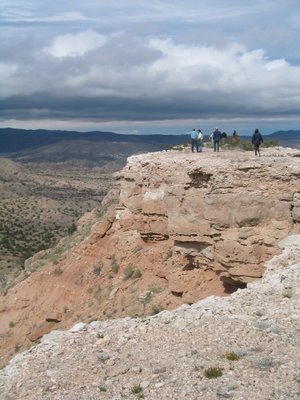
My autumn rural idyll continues. Last weekend we visited the Sevilleta National Wildlife Refuge, which is open to the public only one day per year.
Sevilleta was formerly the enormous Campbell Ranch, which was deeded over thirty years ago to the Nature Conservancy, which in turn gave it to the government, with many restrictions on how it was to be used.
The land has been unused ever since, inhabited only by wildlife, the occasional researcher, and the public (but only once a year).
We took a geology tour with a professor from Tech, Dave Johnson. Our friend Noel Barstow joined us along with her Nissan Pathfinder 4-wheel-drive, so that we could bound up mountains, crash through arroyos, and zoom along riverbeds with a reasonable expectation of not getting killed, or (worse) of having to be towed out.
Our trip took in a colossal number of features of the Rio Grande rift. There is a pool of magma located roughly under Socorro, NM, which in relatively recent geological history heaved up a great mountainous bulge pierced by volcanoes and volcanic vents. The magma pool then began to act to spread out the bulge to east and west, creating a rift valley bounded by ridges and mountains piled up like spilled dominos on either side.
Or, as Dr. Johnson (ours, not theirs) put it, “A million years here, a million years there, and you get whole centimeters of movement.”
The Rio Grande now meanders down the center of the rift, and if the rift formation continues, we’ll get an arm of the Gulf of Mexico creeping up from Texas.
The area is still seismically active, with many small shocks every day, few of which ever get to the window-rattling stage. At least the volcanos have stopped exploding.
The terrain at Sevilleta is enormously varied, from mountains to ridges to plains to alluvial rivers. Aside from the primitive roads and the occasional seismometer or tiltmeter, there is no sign of human habitation. At one point we climbed high up a ridge— see the photo— from which we could view the entire Rio Grande rift, from the Chupadera Mountains on the East to the Colorado Plateau on the West. (The Colorado Plateau is that which contains the Cedar Breaks, Bryce Canyon, and the Grand Canyon, among other geologic spectacles.)
At one point, as we raced down a nearly-dry river bed surrounded on both sides by spectacular, sculpted alluvial mud, Kathy remarked, “You know, I’m used to seeing this kind of thing from a raft.”
At another point, as the Nissan heaved itself out of a canyon and we saw a plain before us, all bright yellow grasses marked by the splodges of bright green trees, Noel said, “It’s just like the Great Rift in Africa!” She should know— when she’s not working at Tech, her job is to fly to, say, Kenya, or Tibet, and plant seismic detectors there.
Without a host of cattle grazing the place down to nothing, Sevilleta is slowly returning to its original state. I’ve never seen such a wide variety of geology packed into such a little space.
Sevilleta will be open again next autumn. Put it on your calendar.